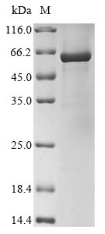Recombinant Human Glutamate receptor 2 (GRIA2) , partial
CAT:
399-CSB-EP009899HU-01
Size:
1 mg
Price:
Ask
- Availability: 24/48H Stock Items & 2 to 6 Weeks non Stock Items.
- Dry Ice Shipment: No




Recombinant Human Glutamate receptor 2 (GRIA2) , partial
- CAS Number: 9000-83-3
- Gene Name: GRIA2
- UniProt: P42262
- Expression Region: 25-543aa
- Organism: Homo sapiens
- Target Sequence: NSIQIGGLFPRGADQEYSAFRVGMVQFSTSEFRLTPHIDNLEVANSFAVTNAFCSQFSRGVYAIFGFYDKKSVNTITSFCGTLHVSFITPSFPTDGTHPFVIQMRPDLKGALLSLIEYYQWDKFAYLYDSDRGLSTLQAVLDSAAEKKWQVTAINVGNINNDKKDEMYRSLFQDLELKKERRVILDCERDKVNDIVDQVITIGKHVKGYHYIIANLGFTDGDLLKIQFGGANVSGFQIVDYDDSLVSKFIERWSTLEEKEYPGAHTTTIKYTSALTYDAVQVMTEAFRNLRKQRIEISRRGNAGDCLANPAVPWGQGVEIERALKQVQVEGLSGNIKFDQNGKRINYTINIMELKTNGPRKIGYWSEVDKMVVTLTELPSGNDTSGLENKTVVVTTILESPYVMMKKNHEMLEGNERYEGYCVDLAAEIAKHCGFKYKLTIVGDGKYGARDADTKIWNGMVGELVYGKADIAIAPLTITLVREEVIDFSKPFMSLGISIMIKKPQKSKPGVFSFLDPLA
- Tag: N-terminal 10xHis-tagged and C-terminal Myc-tagged
- Source: E.coli
- Field of Research: Neuroscience
- Assay Type: In Stock Protein
- Relevance: Receptor for glutamate that functions as ligand-gated ion channel in the central nervous system (PubMed:31300657). It plays an important role in excitatory synaptic transmission. L-glutamate acts as an excitatory neurotransmitter at many synapses in the central nervous system. Binding of the excitatory neurotransmitter L-glutamate induces a conformation change, leading to the opening of the cation channel, and thereby converts the chemical signal to an electrical impulse. The receptor then desensitizes rapidly and enters a transient inactive state, characterized by the presence of bound agonist. In the presence of CACNG4 or CACNG7 or CACNG8, shows resensitization which is characterized by a delayed accumulation of current flux upon continued application of glutamate. Through complex formation with NSG1, GRIP1 and STX12 controls the intracellular fate of AMPAR and the endosomal sorting of the GRIA2 subunit toward recycling and membrane targeting (By similarity).
- Purity: Greater than 85% as determined by SDS-PAGE.
- Activity: Not Test
- Length: Partial
- Form: Liquid or Lyophilized powder
- Buffer: If the delivery form is liquid, the default storage buffer is Tris/PBS-based buffer, 5%-50% glycerol. If the delivery form is lyophilized powder, the buffer before lyophilization is Tris/PBS-based buffer, 6% Trehalose, pH 8.0.
- Reconstitution: We recommend that this vial be briefly centrifuged prior to opening to bring the contents to the bottom. Please reconstitute protein in deionized sterile water to a concentration of 0.1-1.0 mg/mL.We recommend to add 5-50% of glycerol (final concentration) and aliquot for long-term storage at -20℃/-80℃. Our default final concentration of glycerol is 50%. Customers could use it as reference.
- Molecular Weight: 63.3 kDa
- References & Citations: "AMPA receptor GluA2 subunit defects are a cause of neurodevelopmental disorders." SYNAPS Study Group Salpietro V., Dixon C.L., Guo H., Bello O.D., Vandrovcova J., Efthymiou S., Maroofian R., Heimer G., Burglen L., Valence S., Torti E., Hacke M., Rankin J., Tariq H., Colin E., Procaccio V., Striano P., Mankad K. Houlden H. Nat. Commun. 10:3094-3094 (2019)
- Storage Conditions: The shelf life is related to many factors, storage state, buffer ingredients, storage temperature and the stability of the protein itself. Generally, the shelf life of liquid form is 6 months at -20℃/-80℃. The shelf life of lyophilized form is 12 months at -20℃/-80℃.
